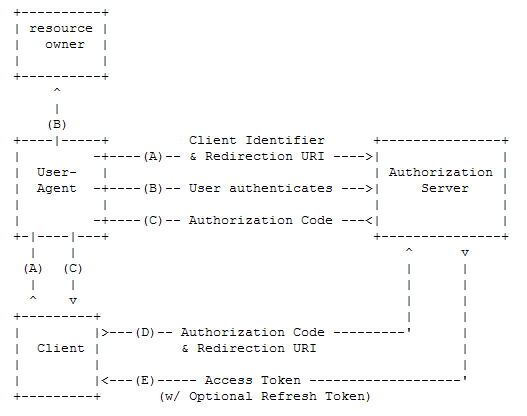.NET Core+QQ第三方授權登錄
安裝包
dotnet add package AspNet.Security.OAuth.QQ
申請過程不介紹了,申請者資料,個人也是可以申請成功的。
這時候有二個參數就是clientid clientsecret
APP ID:xxxx
APP Key:xxxxxx
其中平台資訊,這個申請審核通過後,不要修改,千萬不要隨便修改,一修改就要重新審核。
網站回調域:可以隨便修改,並且可以寫多個,中間用英文逗號分隔即可。
比如,網站地址填的://api.igeekfan.cn,下面如果是localhost,是可以的,但如果是域名,便只能是//api.igeekfan.cn這個域名下的路徑。
網站回調域配置,後台是運行在//localhost:5001埠上。
//api.igeekfan.cn/signin-qq;//localhost:5001/signin-qq
介面介紹
server-side模式,是OAuth2.0認證的一種模式,又稱Web Server Flow;

獲取Authorization Code
//graph.qq.com/oauth2.0/authorize
通過Authorization Code獲取Access Token
//graph.qq.com/oauth2.0/token
獲取用戶OpenID_OAuth2.0
//graph.qq.com/oauth2.0/me
獲取用戶個人資訊
//graph.qq.com/user/get_user_info
使用Authorization_Code獲取Access_Token
接入流程如下:
- 先獲取Authorization Code;
- 通過Authorization Code獲取Access Token
1.Step1:獲取Authorization Code
GET
具體參數可查看官網。
state由用戶自己創建一個隨機數,以防止CSRF攻擊。
如果用戶成功登錄並授權,則會跳轉到指定的回調地址,並在redirect_uri地址後帶上Authorization Code和原始的state值。如:
//localhost:5001/signin-qq?code=B6D497755EACE4635115FC82BE24F280&state=123abc
後台先根據state驗證是自己發出的請求,判斷是否相同,不相同,則代表非本項目發出的授權登錄請求。
- 根據code獲取access_token
GET
這時候你會得到
access_token=1B6E45FA99BA3D6B347713440C9BCEFE&expires_in=7776000&refresh_token=8DB1D48D95C85D3EF593936B8ACE5EE0
獲取用戶OpenID_OAuth2.0
GET
//graph.qq.com/oauth2.0/me?access_token=1B6E45FA99BA3D6B347713440C9BCEFE
openid是此網站上唯一對應用戶身份的標識
callback( {"client_id":"101867513","openid":"951560F5C7A5AA9E5E599CF9B4ECFFB2"} );
獲取用戶的其他資訊
用戶資訊
{
"ret": 0,
"msg": "",
"is_lost":0,
"nickname": "、天上有木月OvO",
"gender": "xxx",
"gender_type": 1,
"province": "xxx",
"city": "xxx",
"year": "2019",
"constellation": "",
"figureurl": "http:\/\/qzapp.qlogo.cn\/qzapp\/101867513\/951560F5C7A5AA9E5E599CF9B4ECFFB2\/30",
"figureurl_1": "http:\/\/qzapp.qlogo.cn\/qzapp\/101867513\/951560F5C7A5AA9E5E599CF9B4ECFFB2\/50",
"figureurl_2": "http:\/\/qzapp.qlogo.cn\/qzapp\/101867513\/951560F5C7A5AA9E5E599CF9B4ECFFB2\/100",
"figureurl_qq_1": "//thirdqq.qlogo.cn/g?b=oidb&k=bjXoWmdlu8fk1m80MCkibMg&s=40&t=1559108425",
"figureurl_qq_2": "//thirdqq.qlogo.cn/g?b=oidb&k=bjXoWmdlu8fk1m80MCkibMg&s=100&t=1559108425", "figureurl_qq": "//thirdqq.qlogo.cn/g?b=oidb&k=bjXoWmdlu8fk1m80MCkibMg&s=640&t=1559108425"
}
程式碼
services.AddAuthentication(xxx)
.AddGitHub(xxx)
加上AddQQ的配置項
.AddQQ(options =>
{
options.ClientId = Configuration["Authentication:QQ:ClientId"];
options.ClientSecret = Configuration["Authentication:QQ:ClientSecret"];
})
appsettings.json中配置項
"Authentication": {
//下面為新增項
"QQ": {
"ClientId": "xx",
"ClientSecret": "xxx"
}
}
對,沒錯,QQ登錄,已經結束了。接下來就是把這些用戶的資訊保存到資料庫,生成token的過程。
這裡
[HttpGet("signin-callback")]
public async Task<IActionResult> Home(string provider, string redirectUrl = "")
{
AuthenticateResult authenticateResult = await _contextAccessor.HttpContext.AuthenticateAsync(provider);
if (!authenticateResult.Succeeded) return Redirect(redirectUrl);
var openIdClaim = authenticateResult.Principal.FindFirst(ClaimTypes.NameIdentifier);
if (openIdClaim == null || string.IsNullOrWhiteSpace(openIdClaim.Value))
return Redirect(redirectUrl);
ClaimsPrincipal principal=authenticateResult.Principal;
//根據provider,處理用戶的基礎資訊,
long id =SaveQQAsync(principal, openIdClaim.Value)
//xxx
}
openIdClaimopenIdClaim是唯一值
lin_user表
| 欄位 | 類型 | 備註 |
|---|---|---|
| Id | long | 主鍵 |
| Username | varchar(50) | 用戶名 |
| Avatar | varchar(50) | 頭像 |
lin_user_identity表
用戶授權資訊表,用於存儲不同登錄類型的用戶資訊,如手機號、郵件、用戶名、第三方應用(微信、QQ、GitHub)的登錄
| 欄位 | 類型 | 備註 |
|---|---|---|
| Id | long | 主鍵 |
| IdentityType | varchar(50) | 認證類型,如 Password,GitHub、QQ、WeiXin等 |
| Identifier | varchar(24) | 認證者,例如 用戶名(PassWord認證類型),授權得到的昵稱(QQ),授權得到的用戶名(唯一,GitHub) |
| Credential | varchar(50) | 憑證,例如 密碼,存OpenId、Id,同一IdentityType的OpenId的值是唯一的 |
| CreateUserId | long | 綁定的用戶Id |
根據openId,判斷lin_user_identity表中是否存在這一第三方授權資訊,如果存在,則返回當前用戶lin_user表中的id,如果不存在,則創建一個新的用戶資訊,插入lin_user、lin_user_identity表中。
public async Task<long> SaveQQAsync(ClaimsPrincipal principal, string openId)
{
string nickname = principal.FindFirst(ClaimTypes.Name)?.Value;
string gender = principal.FindFirst(ClaimTypes.Gender)?.Value;
string picture = principal.FindFirst(QQAuthenticationConstants.Claims.PictureUrl)?.Value;
string picture_medium = principal.FindFirst(QQAuthenticationConstants.Claims.PictureMediumUrl)?.Value;
string picture_full = principal.FindFirst(QQAuthenticationConstants.Claims.PictureFullUrl)?.Value;
string avatar = principal.FindFirst(QQAuthenticationConstants.Claims.AvatarUrl)?.Value;
string avatar_full = principal.FindFirst(QQAuthenticationConstants.Claims.AvatarFullUrl)?.Value;
Expression<Func<LinUserIdentity, bool>> expression = r =>
r.IdentityType == LinUserIdentity.QQ&& r.Credential == openId;
LinUserIdentity linUserIdentity =await _userIdentityRepository.Where(expression).FirstAsync();
long userId = 0;
if (linUserIdentity == null)
{
LinUser user = new LinUser
{
Avatar = avatar_full,
Nickname = nickname,
Username = "",
LinUserIdentitys = new List<LinUserIdentity>()
{
new LinUserIdentity
{
CreateTime = DateTime.Now,
Credential = openId,
IdentityType = LinUserIdentity.GitHub,
Identifier = nickname,
}
}
};
await _userRepository.InsertAsync(user);
userId = user.Id;
}
else
{
userId = linUserIdentity.CreateUserId;
}
return userId;
}
上文中的CreateToken,直接將 authenticateResult.Principal.Claims.ToList(),生成token值,會缺少一些系統需要的值,比如鍵為ClaimTypes.NameIdentifier,應為用戶的id,用戶的其他資訊,如角色/分組,昵稱。不同平台的授權登錄,鍵有所不同,所以這裡需要二次處理。
[HttpGet("signin-callback")]
public async Task<IActionResult> Home(string provider, string redirectUrl = "")
{
//xxx
ClaimsPrincipal principal=authenticateResult.Principal;
List<Claim> authClaims = principal.Claims.ToList();
long id =SaveQQAsync(principal, openIdClaim.Value)
LinUser user =await _userRepository.Select.IncludeMany(r => r.LinGroups)
.WhereCascade(r => r.IsDeleted == false).Where(r => r.Id == id).FirstAsync();
List<Claim> claims = new List<Claim>()
{
new Claim(ClaimTypes.NameIdentifier,user.Id.ToString()),
new Claim(ClaimTypes.GivenName,user.Nickname??""),
new Claim(ClaimTypes.Name,user.Username??""),
};
user.LinGroups?.ForEach(r =>
{
claims.Add(new Claim(LinCmsClaimTypes.Groups, r.Id.ToString()));
});
claims.AddRange(authClaims);
string token = this.CreateToken(claims);
return Redirect($"{redirectUrl}?token={token}#login-result");
}
前台login-result路由,解析到token值,並保存起來,與用戶密碼登錄後的流程相同。


